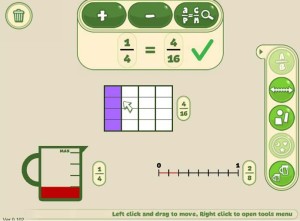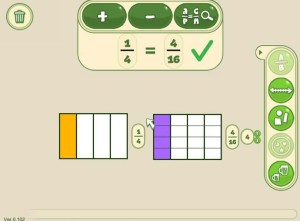The use of technology in education is a highly topical issue. Many papers and articles have been written on the topic, displaying a wide variety of opinions. Lisa Nielsen, creator of a learning blog which has a huge number of followers, recently posted an article entitled ‘Stop saying “balance is key” when discussing technology’. In this post she outlines that:
…technology is a tool and resource that we have at our disposal to use effectively and efficiently for our needs.
Without getting into the querelle, at iTalk2Learn we agree that technology can be adapted to our needs.
We believe that Fractions Lab is a strong example of how technology can
provide useful and effective tools both for teachers and students.

This blog post is designed to show you why it will be more than worth your while to consider using Fractions Lab in your classroom once the project is complete. While we are purposely light-hearted and somewhat contentious here, you are encouraged to refer to the project’s publications for details of the research around this area.
So here are our top 5 reasons you should be interested in Fractions Lab!
1. If you are keen on flexibility and freedom of use
Freedom of use and flexibility are two of the main features of Fractions Lab.
Fractions Lab can be used flexibly: fractions can be modelled by the whole class, small groups or individuals. It can be used in school or at home.
Since it is an Exploratory Learning Environment (ELE), Fractions Lab provides learners with the freedom to interact with the learning environment by means of trialling their ideas. Children acquire knowledge while freely experiencing the environment. They can draft or redraft their work until they are satisfied with it, they can experiment with changing aspects of a fraction, which may be difficult or even impossible for them to do otherwise.
2. If your pupils need some motivation in maths
Is widely known that teachers are faced with the challenge of thinking creatively and incorporating new strategies in order to motivate students. Fractions Lab is not only one of those strategies, but it can stimulate students to pose ‘what-if’ questions, then create and manipulate fractions to answer them. The system is not designed to provide the results; it encourages students to be effective independent learners.

Figure 1: Fractions Lab showing three representations and the ‘equivalence’ tool
3. If you love user friendly design
The environment is designed to be instinctive, so that students and teachers do not have to waste time trying to figure out how it works. For instance, if a fractions is no longer useful it can be deleted by simply dragging it to the bin at top of the screen.
Other examples include the ‘equivalence’ tool, which provides feedback on whether two fractions are equivalent and the ‘partition’ tool, which enables fractions to be split. More importantly, the system has been developed so that users can receive different kinds of hints and tips about its functionalities or even alternative thinking processes.

Figure 2: ‘Equivalence’ tool being used with area representations. The ‘partition’ tool has split 1/4 into four further sections to form 4/16.
4. If you are keen on references
Fractions Lab comes out from a theoretical ground and from the joint work of experienced researchers in mathematics education, educational design and game developers.
Moreover, many teachers and students have already tried Fractions Lab during some workshops and they have hailed it and responded with enthusiastic comments.
5. If you had enough of drawing on the blackboard
Fractions Lab can save you chalk. Achieve better result and never have to draw on the blackboard to teach fractions again!
Fractions Lab offers a range of functionalities and representations (including symbols, number lines, geometrical shapes, liquid measures, and sets of objects) that allow children to understand fractions conceptually in the experimental area. It also offers a variety of tools to help students understand fraction operations (such as equivalence, addition and subtraction).
Want more?
Fractions Lab is included in the iTalk2Learn platform sequenced with structured tasks to support robust learning. We plan to create a website with suggested tasks and supporting materials.
If you agree with the reasons above and you’re interested in trying it our for yourself, contact us and we will be happy to share our draft materials.
If you have already tried Fractions Lab through the iTalk2Learn project, let us know what you think by commenting below!


